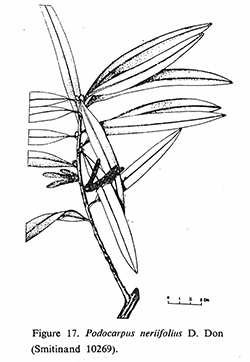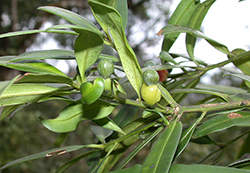e-Flora of Thailand
Volume 2 > Part 3 > Year 1975 > Page 199 > Podocarpaceae > Podocarpus
1. Podocarpus neriifolius D.Donwfo-0000485162
in Lambert, Descr. Genus Pinus ed. 1.2: 21. 1824; Hook.f., Fl. Br. Ind. 5: 649. 1888; Kent in Veitch’s Man. Conif.: 152. 1900; Pilger in Pflanzenr. Taxaceae 18: 80. 1903; Dallim & Jacks., Handb. Of Conif.: 77. 1923; Ridl., Fl. Malay Penins. 5: 281. 1925; Hickel in Fl. Gén. J.-C. 5: 1069. 1931; Wasscher, Blumea 4: 437. 1941; Suvatabandhu, J. natn. Res. Coun. Thailand 2: 62. 1961;Larsen, Dansk Bot. Ark. 20: 123. 1962; Back. & Bakh. F., Fl. Java 1: 90. 1963. Fig. 17.
Accepted Name : This is currently accepted.
Description : Tree up to 30 m high, 200 cm in girth. Leaves coriaceous, linear-lanceolate, 7–20 by 1–1.8 cm, apex acute, base cuneate; petiole 0.3–0.7 cm. Strobili greenish yellow, 2–3 cm long, on shortly or sessile peduncles with several short ovate thick scales at the base. ♂ flowers solitary, receptacle ± 0.5 cm on a stalk ± 1cm. Ovule ellipsoid or sub-globose. Seeds elliptic-ovate, somewhat oblique, 1.1–1.3 by 0. 9 cm.
Thailand : NORTHERN: Chiang Mai, Chiang Rai, Nakhon Sawan; NORTH-EASTERN: Loei, Udon Thani; EASTERN: Nakhon Ratchasima; SOUTH-EASTERN: Trat; PENINSULAR: Krabi, Nakhon Si Thammarat, Trang, Narathiwat.
Distribution : India (type), China, Laos, Vietnam, Cambodia, Malesia.
Ecology : Frequent in evergreen forests, 600–1,300 m alt. Flowering: January–March; fruiting: March–June.
Vernacular : Phaya mai (พญาไม้), sang ching (ซางจิง), samun la waeng (สมุลละแว้ง), maha chang (มหาจาง)(Northern); phai lamton (ไผ่ลำต้น)(Northeastern); hang kai (ฮังไก้), khun mai (ขุนไม้), phaya dairak (พญาได้ราก), phaya mai (พญาไม้)(Eastern).
Uses: The light yellow and even-grained wood is mostly used for furniture and cabinet work.


